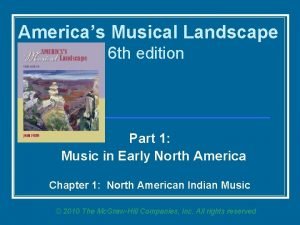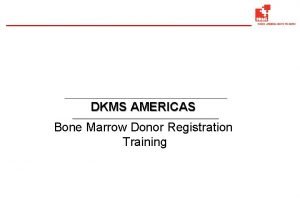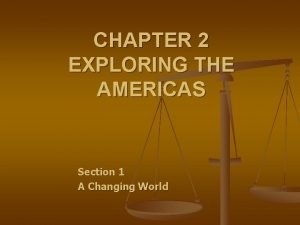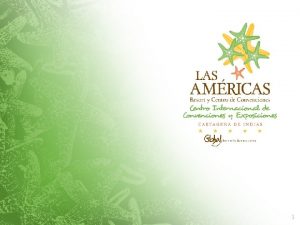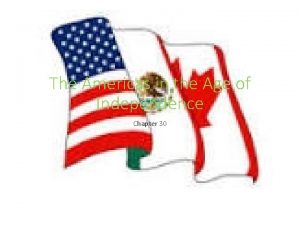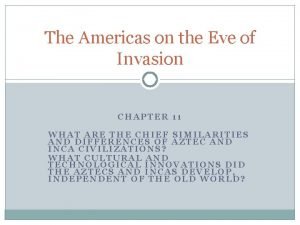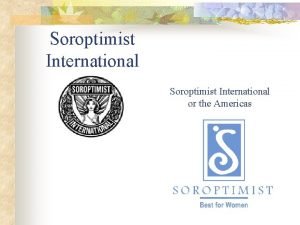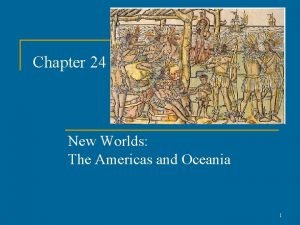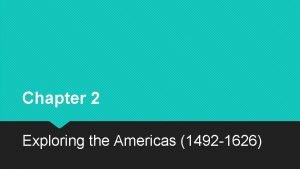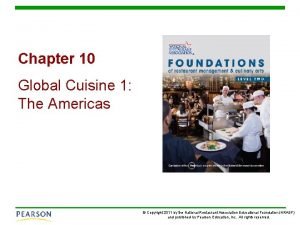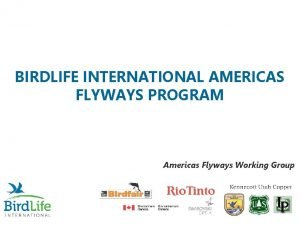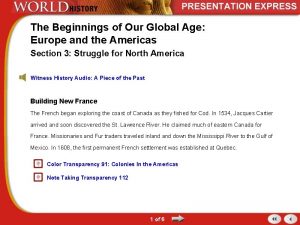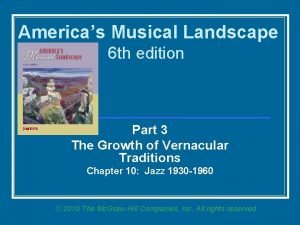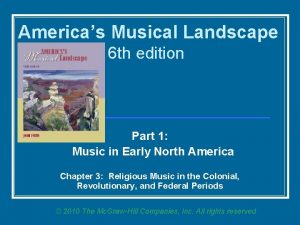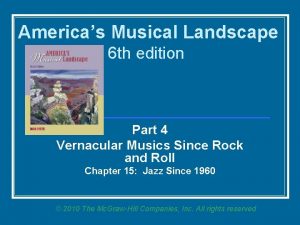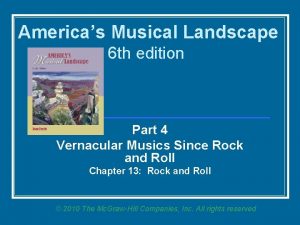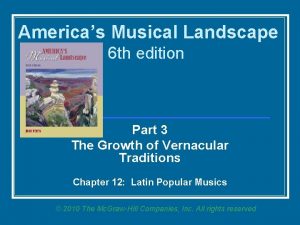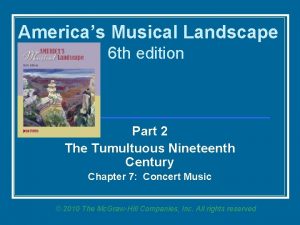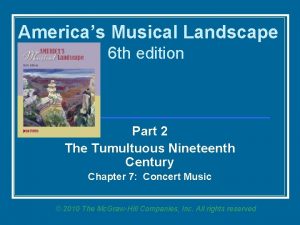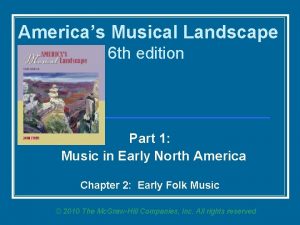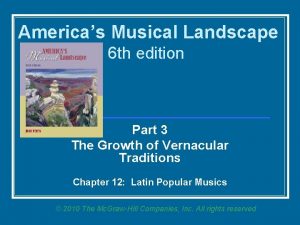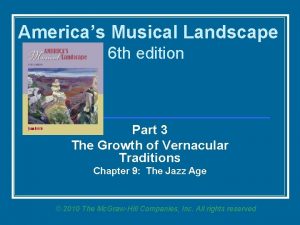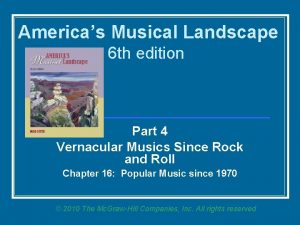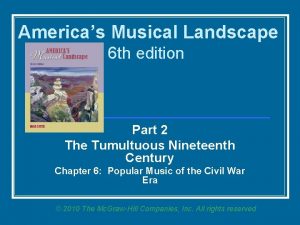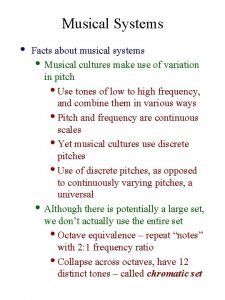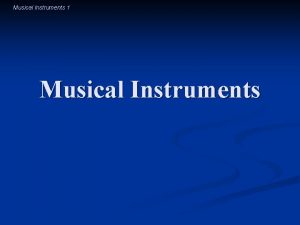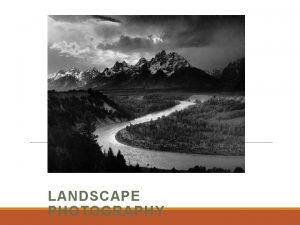Americas Musical Landscape 6 th edition Part 1






















- Slides: 22

America’s Musical Landscape 6 th edition Part 1: Music in Early North America Chapter 2: Early Folk Music © 2010 The Mc. Graw-Hill Companies, Inc. All rights reserved

Early Folk Music n Folk Music = Simple songs and instrumental pieces whose origin has been lost or forgotten n Or music composed in an informal style traditional in certain cultures n Unpretentious, easy to remember and to perform, folk music appeals to inexperienced listeners and sophisticated musicians alike n Folk music of the United States springs from many ethnic and cultural sources n English, Irish, Scottish, Welsh, German, other European influences, Africa—especially West Africa © 2010 by The Mc. Graw-Hill Companies, Inc. All rights reserved. Part 1: Music in Early North America Chapter 2: Early Folk Music 2

Early Folk Music: Spanish Traditions n n Spanish traditions date from 1565, when the Spanish founded St. Augustine, Florida--The oldest European settlement in the United States Today in the Southwest, Spanish folk songs and hymns (religious songs) are heard, reflecting origins in seventeenthcentury Spain or more recent Mexico Alabados = Spanish hymns (religious songs of praise) n Sung without measure, the rhythm conforming to that of the words Corridos = Storytelling songs or ballads n Songs relating the unofficial history of Mexican or Mexican. American communities and their heroes n Often informed people of newsworthy events © 2010 by The Mc. Graw-Hill Companies, Inc. All rights reserved. Part 1: Music in Early North America Chapter 2: Early Folk Music 3

Listening Example 4 El corrido de Gregorio Cortez Anonymous Listening guide page 30 The story concerns a young Mexican falsely accused of horse stealing. When captured, in self defense he shot and killed the arresting sheriff, who had fatally wounded the young man’s brother. Genre: Corrido (norteño ballad) Timbre: Male duet, singing in simple harmony, accompanied by accordion and guitar Meter: Triple. Notice the oom-pah rhythm of a waltz Texture: Homophonic (chordal) The Texas-Mexican border performance style called norteño often includes accordion © 2010 by The Mc. Graw-Hill Companies, Inc. All rights reserved. Part 1: Music in Early North America Chapter 2: Early Folk Music 4

Early Folk Music: British Traditions n n Early English settlers in the New World brought few musical instruments with them n Violins and other stringed instruments became available; people played British fiddle tunes and dances from their childhood n Many traditional songs acquired new words and altered melodies reflecting American dialects, New World experience These folk music traditions survive today in rural and mountain areas, where the style of singing and playing instruments is close to that of seventeenth-century Britain n Lullabies, nonsense songs, work songs, singing games © 2010 by The Mc. Graw-Hill Companies, Inc. All rights reserved. Part 1: Music in Early North America Chapter 2: Early Folk Music 5

British Traditions: Folk Ballads n Most common of all folk songs are ballads n Ballad = A story told in song n n n Sung from memory by solo voice, with or without accompaniment Strophic in form, often with many stanzas Ballad song texts evolved over long time periods § Singers often add, alter, or delete stanzas, lending a song local or timely relevance, expressing creativity © 2010 by The Mc. Graw-Hill Companies, Inc. All rights reserved. Part 1: Music in Early North America Chapter 2: Early Folk Music 6

Listening Example 5 Barbara Allen Anonymous Listening guide page 32 A favorite of George Washington, this example of a ballad is sometimes called “Barbry Ellen” or another similar name, and probably originated in Scotland The story is of the young “Sweet William, ” who is dying for love of “hard-hearted Barbara Allen, ” who of course loves him and is remorseful for having repelled his advances Form: Strophic, with several four-line stanzas Melody: Based upon a pentatonic scale, which is a fivenote scale within the range of an octave—Barbara Allen uses only the tones of the five black notes of a keyboard Rhythm: Irregular, but a steady underlying pulse with a general sense of triple meter © 2010 by The Mc. Graw-Hill Companies, Inc. All rights reserved. Part 1: Music in Early North America Chapter 2: Early Folk Music 7

Early American Folk Music n Early emigrants reflected the influence of the British broadside… n A topical ballad, printed on a big sheet suitable for display, or in a newspaper n Americans altered traditional ballads to fit their new experiences n n Setting original words to old tunes Broadsides included historical or topical events, moral instruction, political commentary, sometimes satire John Dickinson’s “Liberty Song” © 2010 by The Mc. Graw-Hill Companies, Inc. All rights reserved. Part 1: Music in Early North America Chapter 2: Early Folk Music 8

Early American Folk Music n Songs and instrumental music: n n n Frontier people sang about freedom, equality, danger, beauty of nature Ballads about the Erie Canal (1825), the California gold rush (1849) Slaves had their own music Miners, farmers, railroad workers even outlaws had folk music Lullabies, play party songs Chanteys were sailors’ work songs; popular in New England © 2010 by The Mc. Graw-Hill Companies, Inc. All rights reserved. The Pemigewasset Coach Painted by Enoch W. Perry, Jr. (1831 -1915) Part 1: Music in Early North America Chapter 2: Early Folk Music 9

Listening Example 6 Shenandoah Anonymous Performed by Pete Seeger Listening guide page 35 Oh Shenandoah, I love your daughter. Wa-ay, you rollin’ river. Oh Shenandoah, I love your daughter, Away, we’re bound away ‘Cross the wide Missoura. Oh Shenandoah, I long to see you. Wa-ay, you rollin’ river. Oh, Shenandoah, I’ll not deceive you. Away, we’re bound away ‘Cross the wide Missoura. For seven years I’ve been a rover. Wa-ay, you rollin’ river. For seven years I’ve been a rover. Away, we’re bound away ‘Cross the wide Missoura. Form: Strophic, with refrain at end of each verse Meter: Quadruple Tempo: Slow Accompaniment: Sparse strumming by guitar This song originated in the areas of the Missouri and Mississippi Rivers, traveling down the Mississippi to the ocean, where sailors adopted its rolling melody; Shenandoah was an Indian chief living on the Missouri River © 2010 by The Mc. Graw-Hill Companies, Inc. All rights reserved. Part 1: Music in Early North America Chapter 2: Early Folk Music 10

African Traditions n Early seventeenth century n The first Africans were forcibly brought to America in European slave ships n Many slaveholders harshly discouraged references to African gods and religions in any traditional song or dance n Slaves in New England, treated with more leniency than southern slaves, would entertain themselves and their masters n Singing, dancing, playing musical instruments n The first generation of slaves born in America began to develop their own music, American music rooted in African customs and sounds © 2010 by The Mc. Graw-Hill Companies, Inc. All rights reserved. Part 1: Music in Early North America Chapter 2: Early Folk Music 11

African Traditions: Field Hollers n Slaves working on plantations poured all the anguish of their new, tragic experience into field hollers, which were… n Loud, rhythmically flexible, emotionally expressive chants or cries sung by a solitary voice n Slaves working in a field Some had words but most used neutral syllables, enabling contact with fellow workers over distances © 2010 by The Mc. Graw-Hill Companies, Inc. All rights reserved. Part 1: Music in Early North America Chapter 2: Early Folk Music 12

African Traditions: Ring Shouts n Another African tradition translated to an African American experience was the religious shout or ring shout n Performed at religious services or camp meetings n The “shouters” formed a ring and shuffled energetically to the singing of the spiritual, gradually quickening their pace, barely lifting their feet, falling from exhaustion © 2010 by The Mc. Graw-Hill Companies, Inc. All rights reserved. Part 1: Music in Early North America Chapter 2: Early Folk Music 13

Listening Example 7 Field Holler Listening guide page 38 The field holler enabled the slaves to establish wordless but heartwarming contact with fellow workers who, hearing the poignant cries, could respond with expressive hollers of their own. Timbre: Solo male voice Rhythm: Free, flexible Melody: Simple, narrow, mournful phrase on three tones, repeated Text: Neutral syllables, easy to sing and to hear over distances © 2010 by The Mc. Graw-Hill Companies, Inc. All rights reserved. Part 1: Music in Early North America Chapter 2: Early Folk Music 14

Listening Example 8 Father’s Field Call Listening guide page 38 Notice the sound of the high falsetto range, lying above the normal, full, chest voice Falsetto enhanced the ability to call over long distances Timbre: Solo male voice in falsetto range Rhythm: Free, flexible Melody: Begins with upward leap, succeeded by a naturally falling inflection, reminiscent of the familiar “Yoo-hoo” Text: Wordless © 2010 by The Mc. Graw-Hill Companies, Inc. All rights reserved. Part 1: Music in Early North America Chapter 2: Early Folk Music 15

African Traditions: Work Songs n Work Songs accompanied tasks such as rowing, hoeing, chopping trees n Slaves made up, or improvised work songs n Work songs often set the pace and synchronized movements of forced laborers n Strophic in form n Call-and-response = Leading lines of each verse were sung by a single voice, alternating with a repeated phrase or refrain sung by the group © 2010 by The Mc. Graw-Hill Companies, Inc. All rights reserved. Part 1: Music in Early North America Chapter 2: Early Folk Music 16

Listening Example 9 Hammer, Ring (excerpt) Chorus Won’t you ring, old hammer? Hammer, ring! Performed by Jesse Bradley and group at State Penitentiary, Huntsville, Texas, 1934 Listening guide page 39 Form: Strophic, call-and-response Meter: Duple Hammer songs accompanied men driving the spikes fastening long steel rails to wooden railroad ties; relentless rhythm, driving energy reinforce and support the regular rhythm of the hammering men © 2010 by The Mc. Graw-Hill Companies, Inc. All rights reserved. Part 1: Music in Early North America Chapter 2: Early Folk Music 17

African Traditions: Freedom Songs n During the first half of the nineteenth century, a movement known as the Underground Railroad assisted slaves seeking escape to free states, Canada, or elsewhere n A network of abolitionists, religious groups, and other sympathizers provided fleeing individuals transportation, supplies and safe houses along secret routes n A tragically small, yet significant, number of slaves successfully reached freedom n Freedom songs encouraged members of the Underground Railroad and escapees on their perilous mission © 2010 by The Mc. Graw-Hill Companies, Inc. All rights reserved. Part 1: Music in Early North America Chapter 2: Early Folk Music 18

African Traditions: Musical Instruments n In Africa, drums accompanied work songs, providing two or three underlying complex rhythmic patterns n Many slaves brought small drums and simple string instruments to America n Slaveholders banned the use of African drums, fearing drums would incite revolt n Slaves made percussive instruments from empty oil drums, metal washbasins, more n Slaves clapped, body-slapped, stamped rhythms n Rattles or bits of shell or bone enhanced rhythms n Banjos were created by using a hollowed-out gourd or calabash © 2010 by The Mc. Graw-Hill Companies, Inc. All rights reserved. Part 1: Music in Early North America Chapter 2: Early Folk Music 19

Listening Example 10 No More Auction Block for Me Anonymous Performed by Odetta with mixed chorus Listening guide page 40 This song from the early 1800’s inspired two anthems of the twentieth-century civil rights movement: “We Shall Overcome” and Bob Dylan’s “Blowin’ in the Wind” anthems of the civil rights movement Melody: almost identical to a traditional West African song Texture: Homophonic Form: Strophic This haunting freedom song expresses the determination of slaves to escape the humiliation of being sold at auction © 2010 by The Mc. Graw-Hill Companies, Inc. All rights reserved. Part 1: Music in Early North America Chapter 2: Early Folk Music 20

What of African Music Survives Today? n Today’s African American musics are deeply rooted in African traditions that arrived in the New World with the first slaves n Call-and-response became a basic characteristic of African American vocal and instrumental music n Improvisation is basic within jazz, and colors much other music n Much African American music is still based on the “bent” or flexible tones of the blues scale, unheard in this country until the first West Africans arrived n The emphasis in African American music on rhythm over melody, and the complexity of African rhythms compared with those of Western (European) music is apparent © 2010 by The Mc. Graw-Hill Companies, Inc. All rights reserved. Part 1: Music in Early North America Chapter 2: Early Folk Music 21

Image Credits n Slide 8: John Dickinson’s Liberty Song Public domain n Slide 9: “The Pemigewasset Coach, ” painted by Enoch W. Perry Jr. , Photograph © Corel n Slide 12: Slaves working in a field, Library of Congress (LC-USZ 62 -115201) © 2010 by The Mc. Graw-Hill Companies, Inc. All rights reserved. Part 1: Music in Early North America Chapter 2: Early Folk Music 22
 A vocal slide, as heard in the sioux grass dance
A vocal slide, as heard in the sioux grass dance Using mis 10th edition
Using mis 10th edition Zulily case study
Zulily case study Blood donation form
Blood donation form Dkms americas
Dkms americas Chapter 2 exploring the americas study guide
Chapter 2 exploring the americas study guide The colonial class system
The colonial class system Rochem
Rochem The beginnings of our global age europe and the americas
The beginnings of our global age europe and the americas Theatron of the americas
Theatron of the americas Centro internacional de convenciones
Centro internacional de convenciones The americas in the age of independence
The americas in the age of independence The americas on the eve of invasion
The americas on the eve of invasion Soroptimist international of the americas
Soroptimist international of the americas New worlds the americas and oceania
New worlds the americas and oceania Cómo se enseña
Cómo se enseña Nist frame
Nist frame Chapter 2 exploring the americas answer key
Chapter 2 exploring the americas answer key Declaración sobre seguridad en las américas 2003
Declaración sobre seguridad en las américas 2003 Chapter 10 global cuisine 1 the americas
Chapter 10 global cuisine 1 the americas Hte americas
Hte americas Geonetcast americas
Geonetcast americas The beginnings of our global age europe and the americas
The beginnings of our global age europe and the americas
